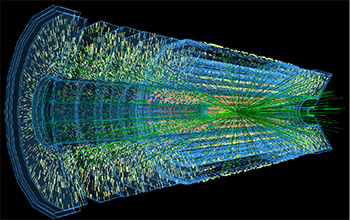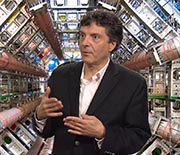News Release 18-071
New institute to address massive data demands from upgraded Large Hadron Collider
Research will develop software for the biggest Big Data challenges

A data visualization from a simulation of proton-proton collisions expected at the HL-LHC.
September 4, 2018
This material is available primarily for archival purposes. Telephone numbers or other contact information may be out of date; please see current contact information at media contacts.
The National Science Foundation (NSF) has launched the Institute for Research and Innovation in Software for High-Energy Physics (IRIS-HEP), a $25 million effort to tackle the unprecedented torrent of data that will come from the High-Luminosity Large Hadron Collider (HL-LHC), the world's most powerful particle accelerator. The upgraded LHC will help scientists fully understand particles such as the Higgs boson -- first observed in 2012 -- and their place in the universe.
When the HL-LHC reaches full capability in 2026, it will produce more than 1 billion particle collisions every second, from which only a few will reveal new science. A tenfold increase in luminosity will drive the need for a tenfold increase in data processing and storage, including tools to capture, weed out and record the most relevant events and enable scientists to efficiently analyze the results.
"Even now, physicists just can't store everything that the LHC produces," said Bogdan Mihaila, the NSF program officer overseeing the IRIS-HEP award. "Sophisticated processing helps us decide what information to keep and analyze, but even those tools won't be able to process all of the data we will see in 2026. We have to get smarter and step up our game. That is what the new software institute is about."
In 2016, NSF convened a Scientific Software Innovation Institute conceptualization project to gauge the LHC data challenge.
Through numerous workshops and two community position papers, the S2I2-HEP project brought together representatives from the high-energy physics and computer science communities. These representatives reviewed two decades of successful LHC data-processing approaches and discuss ways to address the opportunities that lay ahead. The new software institute emerged from that effort.
"High-energy physics had a rush of discoveries and advancements in the 1960s and 1970s that led to the Standard Model of particle physics, and the Higgs boson was the last missing piece of that puzzle," said Peter Elmer of Princeton University, the NSF principal investigator for IRIS-HEP. "We are now searching for the next layer of physics beyond the Standard Model. The software institute will be key to getting us there. Primarily about people, rather than computing hardware, it will be an intellectual hub for community-wide software research and development, bringing researchers together to develop the powerful new software tools, algorithms and system designs that will allow us to explore high-luminosity LHC data and make discoveries."
Bringing together multidisciplinary teams of researchers and educators from 17 universities, IRIS-HEP will receive $5 million per year for five years, with a focus on developing both innovative software and training the next generation of users.
"It's a crucial moment in physics," adds Mihaila. "We know the Standard Model is incomplete. At the same time, there is a software grand challenge to analyze large sets of data, so we can throw away results we know and keep only what has the potential to provide new answers and new physics."
Co-funded by NSF's Office of Advanced Cyberinfrastructure in the Directorate for Computer and Information Science and Engineering (CISE) and the NSF Division of Physics in the Directorate for Mathematical and Physical Sciences (MPS), IRIS-HEP is the latest NSF contribution to the 40-nation LHC effort. It is the third OAC software institute, following the Molecular Sciences Software Institute and the Science Gateways Community Institute.
-NSF-
-
View Video
Bogdan Mihaila describes the extreme software challenges of an upgraded Large Hadron Collider.
Credit and Larger Version -
View Video
Peter Elmer of Princeton University explains how data is critical to understanding fundamental physi
Credit and Larger Version
Media Contacts
Joshua Chamot, NSF, 703-292-4489, email: jchamot@nsf.gov
Linda A. McBrearty, NSF, (703) 292-2251, email: lmcbrear@nsf.gov
Melissa Moss, Princeton University, (609) 865-1212, email: melissamoss@princeton.edu
Sarah Charley, U.S. LHC Communications, (630) 338 3034, email: sarah.charley@cern.ch
Program Contacts
Bogdan Mihaila, NSF, (703) 292-8235, email: bmihaila@nsf.gov
Principal Investigators
Peter Elmer, Princeton University, (609) 258-8071, email: gelmer@princeton.edu
The U.S. National Science Foundation propels the nation forward by advancing fundamental research in all fields of science and engineering. NSF supports research and people by providing facilities, instruments and funding to support their ingenuity and sustain the U.S. as a global leader in research and innovation. With a fiscal year 2023 budget of $9.5 billion, NSF funds reach all 50 states through grants to nearly 2,000 colleges, universities and institutions. Each year, NSF receives more than 40,000 competitive proposals and makes about 11,000 new awards. Those awards include support for cooperative research with industry, Arctic and Antarctic research and operations, and U.S. participation in international scientific efforts.
Connect with us online
NSF website: nsf.gov
NSF News: nsf.gov/news
For News Media: nsf.gov/news/newsroom
Statistics: nsf.gov/statistics/
Awards database: nsf.gov/awardsearch/
Follow us on social
Twitter: twitter.com/NSF
Facebook: facebook.com/US.NSF
Instagram: instagram.com/nsfgov


